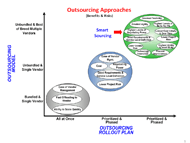|
Outsourcing Strategy
Businesses today have witnessed a dramatic increase in business process outsourcing and technology process outsourcing. Many are choosing to outsource significant components of their value chain to achieve cost advantage, reduce risk, improve their ability to manage variable demand and to allow increased focus on their core competencies. From a strategic relationship perspective, we categorize outsourcing relationships into the following three basic models:
- Strategic Alliance – An integrated third-party partnership that leverages bundles of services to achieve process improvement and improved demand management
- Co-managed – Project focused services, usually skills-based, where responsibility is divided between internal staff and outsource provider resources
- Transaction Oriented – Targeted repetitive operations that can benefit from best practices and economies of scale
Many organizations are leveraging several business partners and using multiple outsourcing models to establish a portfolio strategy. This “best of breed” model, when coupled with an appropriate level of governance, can significantly optimize the organization’s value chain. For example, a management team may choose to bundle all data center services into a single contract, engage several vendors for staff augmentation on a project basis and choose to outsourcing E-Commerce and contract renewal transactions to separate third-parties. Our experience has shown that improving service quality and reducing costs in the long run require this type of “best of breed” approach.
| Evaluation of current projects and operations is an important first step in planning outsourcing arrangements. By determining upfront “core” versus “non-core” business processes, organizations are able to conduct targeted RFP processes and effectively select the best service providers. Through the use of an Intellectual Property Hierarchy model developed by HBSC, it is possible to predict cost savings and understand business impacts with a high degree of accuracy. |
|
Outsourcing can be an important part of transforming the enterprise into a high-performance organization. Important questions to ask when evaluating a potential outsourcing relationship includes: Industry expertise, range of outsourcing services, offshore capabilities, resource scalability, contract flexibility and areas of functional expertise. We recommend that outsourcing should be designed into the organization’s overall Enterprise Architecture prior executing an outsourcing agreement. HBSC has successfully helped numerous organizations navigate the selection, negotiation and change management aspects of establishing high-value outsourcing relationships.
|


